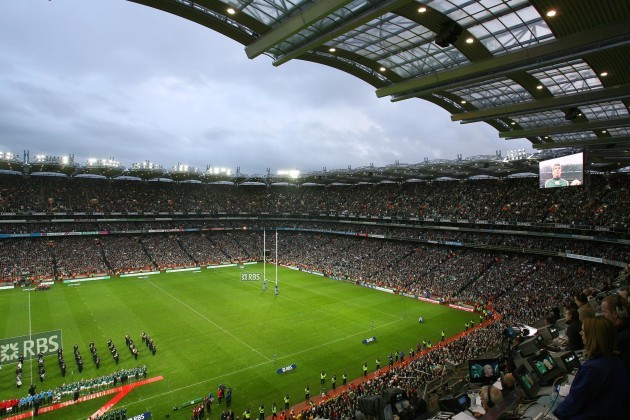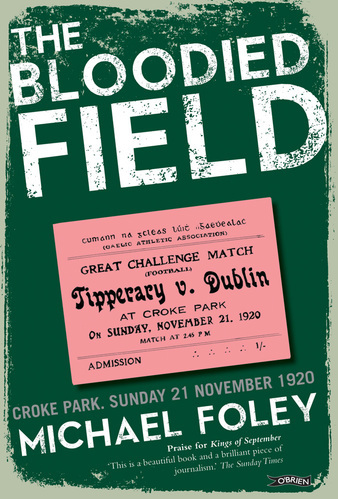STANDING WITH PROTESTERS outside the stadium and sitting next to Paul Ackford inside the stadium.
For Michael Foley, those are the opening recollections of an epic day of sport at Croke Park a decade ago.
It was an occasion that first sparked the interest for him in exploring the events of Bloody Sunday in November 1920, but he began that day by being caught up in the seismic nature of an Ireland-England rugby collision on Jones Road.
“My day in Croke Park started in the pouring rain outside with all the protesters. I’ll always remember there was an old woman who came all the way from America to protest.
“So I did that, I was covering it for The Sunday Times, went in to Croke Park and I remember I was sitting inside the press box next to Paul Ackford, the second row from England.
“Being a child of the 80’s, I remembered watching him on Sports Stadium battering fellas. I was standing beside him for the anthems, they were like nothing that I’d heard before in Croke Park or since. It was just unreal.
“I’ll always remember, the anthems were finished up and Ackford – the Telegraph rugby correspondent at the time – looked to me and goes, ‘we’re fucked’.”
The subsequent 80 minutes of action confirmed Ackford’s fears, Ireland battering England en route to a 43-13 win.
If that match was the final chapter on the long and emotive tale surrounding Rule 42, it kickstarted another narrative.
“I remember a lot of the coverage of Shane Horgan’s try, catching the ball from the O’Gara kick, and how it was a Gaelic football style try,” says Foley.
“There was also this other narrative about his try being near where Michael Hogan was shot. That was what struck me first. I thought it was interesting about Horgan’s try.
“Then I went and read into the Michael Hogan story a little bit and realised he was shot completely the opposite end of the ground. Girvan Dempsey’s try was way closer. It kind of went from there.”
From that initial idea in 2007 came the end product in of ‘The Bloodied Field’ in 2014.
“I started to read a bit more into it after that Ireland-England game. A lot of facts jumped out. There were some mistakes in the total recording of being dead. There was talk that it was an All-Ireland final that day when it was a challenge game.
“Michael Hogan was described in places as the captain, he was a youngster making his way in a Tipperary football career.
“A particular narrative had developed around Bloody Sunday up through the decades and had hardened. It was no one’s fault, just a case of what we were told.
“Like the Michael Collins movie is the reference point for almost everybody. You wouldn’t be critical of Neil Jordan though. He himself explained it as trying to capture the brutality of the crown forces in 10-20 seconds on film.
“I can see where he’s coming from, it’s very, very hard. The actual episode itself lasted 90 seconds. I think if he had access to the research and detail that we have now, I’d say he probably would have gone a different way with it.”
In the couple of years after, Foley was focused on writing other books like ‘Kings of September’ and Mickey Harte’s autobiography. But his interest in the tale of Bloody Sunday never wavered and in 2011 he began to devote himself to the painstaking research of the details of that fateful day.
“To be honest I was afraid of the topic a bit, I was afraid I wouldn’t do it justice.
“Eventually I came to 2011 and thought if I don’t do it and I see someone else do it, I’ll kind of regret not having a go anyway.
“There was one book written about Bloody Sunday in the 60’s, but that was more about the morning in Dublin.
“Bloody Sunday is such an important part of our sport and cultural history. We didn’t really have a grasp of what happened, what it was about. Even something as simple as who died.
“I’d have a view that as a nation we’re great to hang on to our history and use it for all sorts of political means, but we are actually really poor at preserving it.”
“What I found meeting relatives of the victims, they say that these people never spoke about it. They just didn’t want to talk about it and said, ‘they were troubled times’.
“So it was very hard to get a handle on what happened. It’s like a lot of things in Irish history, it’s only now with the benefit of distance that you can get back to the bare facts of what happened.”
What started as a thought during a Six Nations game, reached a conclusion seven years later. The staging of the Ireland-England rugby match at Croke Park may have prompted a fierce political debate in some quarters but for the relatives of the Bloody Sunday victims, it was not an event that had stoked their emotions.
“No it wouldn’t have come up,” says Foley.
“What I remember of the relatives that I did meet, none of them were politicised. None of them held any overwhelming grudges against the British establishment or the crown forces or the GAA or anybody. That’s just the ones I’ve met, there are a few families I haven’t met.
“The deaths on Bloody Sunday – in most of the families that I’ve met – was just something really sad that happened and it was a real tragedy. Down the generations it hadn’t really evolved any more than that for those families.”
**********
‘The Bloodied Field’ is published by O’Brien Press. More information available here.


